3D printing technology adds up for OEM and supplier applications
03 August 2022
How advances in technologies and materials are increasing additive manufacturing’s applications in on- and off-highway equipment
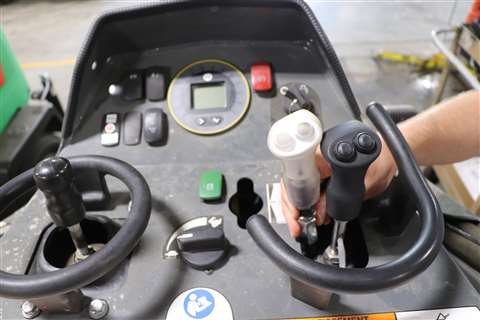 3D printing enabled Wacker Neuson to produce a new joystick grip for test purposes in a matter of hours rather than weeks. (Photo: Wacker Neuson)
3D printing enabled Wacker Neuson to produce a new joystick grip for test purposes in a matter of hours rather than weeks. (Photo: Wacker Neuson)
Additive manufacturing and 3D printing have been a part of the lexicon of the R&D community since the early ‘80s when the technologies were first developed. Yet, while some OEMs and component suppliers dipped a toe in, it took significantly longer for the technologies’ use to obtain a serious foothold in new equipment and parts development.
One of the earlier OEM adopters was construction equipment giant Caterpillar. “Caterpillar has been utilizing additive manufacturing since the mid-‘90s,” said Seth Johnson, engineering manager. “The first 3D printers utilized stereolithography (SLA) technology, which allowed for the creation of very precise and detailed models.” The original material was unsuitable for in-field applications, however, prompting the 3D models to be used largely as visual and teaching aids.
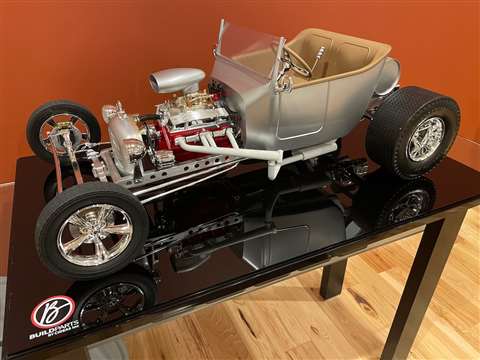 Design verification and display models were among the early uses of 3D printing. (Photo: CIDEAS Inc.)
Design verification and display models were among the early uses of 3D printing. (Photo: CIDEAS Inc.)
Cost of both the design software and equipment was also a limiting factor. “In the early years, CAD software was incredibly expensive,” said Mike Littrell, president and CEO for CIDEAS Inc. and managing director and CEO, Paxis LLC, both of which specialize in additive manufacturing. “The 3D printers were incredibly slow, expensive and difficult to operate. As a result, 3D-printed parts were expensive, so it was somewhat relegated to the medical, aerospace and automotive industries.
“Then, in 1997, SolidWorks offered an industrial CAD application with a $3,500 price tag,” he noted, “opening the flood gates to more vertical markets.”
Opportunities for mobile equipment expand
With the significant dip in costs, more manufacturers began to explore the technologies’ potential.
“Design verification models were the typical end uses at the time. The accuracy was pretty impressive, and it allowed companies to reduce product development cycles exponentially,” Littrell said. “In fact, many of my customers didn’t want their competitors to know that they were using the service to gain a competitive edge in bringing products to market much quicker.”
Roughly 10 years ago, Cideas used additive manufacturing to build a “board room model” of a hybrid transmission for a bus manufacturer that included all the third-party connectors and components and measured over 4 ft. in length. A second model was commissioned and placed directly into a bus chassis.
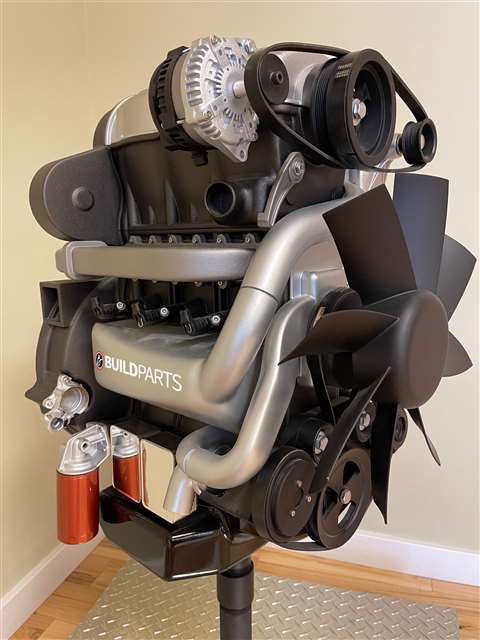 Shown is a 3D printed engine from CIDEAS Inc.
Shown is a 3D printed engine from CIDEAS Inc.
“The second- and third-tier suppliers were invited out to hook up their wiring and other components,” said Littrell. “This allowed them to modify, develop and make changes on the fly, saving weeks if not months in development time. It also allowed suppliers to catch costly errors or create more efficient designs.”
David Giebehain, 3DP global product director, Protolabs, a rapid prototyping and on-demand production service, saw similar applications emerge. “In 2014 and 2015, much of the application work for additive was focused on quick-turn prototyping for customers in various industry segments,” he said. “Medical device and computer electronics have historically shared a large slice of the industry segment pie. Stereolithography played, and continues to play, a nice role here.”
In addition, other industries began “waking up to the benefits of additive manufacturing,” said Giebehain – including industrial machinery and equipment, aerospace and automotive – as the capabilities of the systems used and materials available continued to expand.
“The vertical markets grew considerably once CAD software became readily available. As the technologies became faster and more materials became available, the end uses became more diverse,” Littrell noted. Today, his company works with “every vertical market that creates a tangible product.”
“And the additive-manufactured and 3D-printed parts can be anything from design verification, marketing, end-use parts, bridge tooling, jigs and fixtures for the production floor and more,” he added.
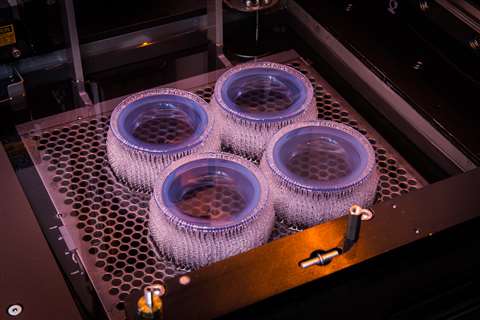 Additive-manufactured and 3D-printed parts can be anything from design verification, marketing, end-use parts, bridge tooling, jigs and fixtures for the production floor and more. (Photo: Protolabs)
Additive-manufactured and 3D-printed parts can be anything from design verification, marketing, end-use parts, bridge tooling, jigs and fixtures for the production floor and more. (Photo: Protolabs)
The applications continue to evolve. “In an industrial setting, engineers are often evaluating machining, molding and casting as potential manufacturing processes. Now, we are experiencing more thoughtfulness around the value that additive manufacturing could bring to these larger industry segments,” Giebehain stated.
“The best projects we’ve seen,” he continued, “have been able to leverage component and supply chain consolidation while simultaneously optimizing key design features that enable performance outcomes (e.g., lightweighting) that would be impossible to achieve using traditional manufacturing methods.”
Internal and in-field use
More than two decades into the technology’s use, Caterpillar has expanded its in-house additive manufacturing capabilities to include Digital Light Synthesis (DLS), Selective Laser Sintering (SLS), Fused Deposition Modeling (FDM), Selective Laser Melting (SLM) and SLA technologies. It also takes advantage of outside services when needed.
“Through Caterpillar’s supplier network, we have access to almost every 3D printing technology currently available in the industry,” Johnson said.
The technology utilized is based on the type of part being printed and its end application. “For example, a part being used for a visual aid would be ideal for an SLA printer, whereas a structural part for in-field use would be a candidate for an SLM printer,” said Johnson. “The timeframe is dependent on the part size and material, but 3D printing can reduce lead times down from months to weeks and in many cases even days.”
 More than two decades into the technology’s use, Caterpillar has expanded its in-house additive manufacturing capabilities to include multiple processes and materials. (Photo: Caterpillar Inc.)
More than two decades into the technology’s use, Caterpillar has expanded its in-house additive manufacturing capabilities to include multiple processes and materials. (Photo: Caterpillar Inc.)
Rapid development and testing of prototype parts continues to help speed product development. “This has enabled quick turnaround iterations for testing and validating concept designs, significantly reducing the development timeline and tooling cost for many applications,” Johnson said. “In addition to reducing the timeframe for part development, utilizing 3D printing for fixtures and manufacturing equipment has reduced the lead time to validate production intent processes.”
Additive manufacturing is also being used to produce current production and service parts. “Caterpillar prints many different types of metallic, plastic and polymer materials and now utilizes 3D-printed parts for in-field applications,” Johnson said. “The value to the customer has been reduced cost, increased availability and improved performance.”
Reduced costs and lead times
Though slightly newer to 3D printing, compact equipment and construction machinery provider Wacker Neuson has been taking advantage of the technology for more than a decade. It currently uses a Makerbot Replicator+ and Ender 3 V2 (modified) for FDM applications, and a Formlabs Form 2 for SLA/Resin printing.
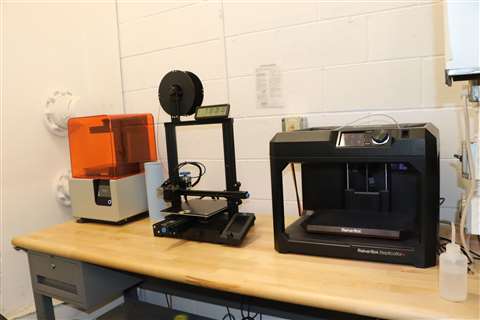 Wacker Neuson currently uses a Makerbot Replicator+ and Ender 3 V2 (modified) for FDM applications, and a Formlabs Form 2 for SLA/Resin printing. (Photo: Wacker Neuson)
Wacker Neuson currently uses a Makerbot Replicator+ and Ender 3 V2 (modified) for FDM applications, and a Formlabs Form 2 for SLA/Resin printing. (Photo: Wacker Neuson)
“The Form2 has a build volume of 145 x 145 x 175mm. Most resin prints will be under this size,” Zachary Lutz, engineering manager – New Product Development, Wacker Neuson, noted. “The Ender has a build volume of 220 x 220 x 250mm. Any prints larger than that build volume are sent to an external supplier with larger capabilities.
“Our primary use is on the Ender 3, with prints ranging from 30-minute small fitment gauges and assembly fixtures up to multi-day prints for prototype shrouds/enclosures,” he said. “Typically, FDM requires less than 10 minutes of cleanup from the user after the print is done.”
The result is significant reductions in both prototyping costs and lead times on plastic components.
“During loader development, all of the plastic parts within the operator cabin were 3D printed,” Lutz said. “The parts were produced in a matter of a week and provided for fit-up. Traditionally, ordering prototypes for plastic injection-molded parts would have required prototype tooling of some sort and an eight-plus week lead time.”
The SLA printer – typically reserved for higher quality parts – was utilized with the UTL product line to produce a new joystick grip that was to be tested for texture and ergonomics. Each iteration was evaluated by a number of operators, with feedback solicited and modifications made.
Rather than weeks using traditional methods, “a typical print for one of the grips would take about six to 12 hours with less than one hour of cleanup/prep from the user,” Lutz noted. This ability to rapidly print the grip enabled three design iterations to be readily produced over the course of three months of testing.
Wacker Neuson plans to expand its use of 3D printing for the project. “Since this UTL grip has a relatively low annual volume (<1000), we made the decision to produce this grip using additive manufacturing instead of injection molding,” Lutz said. “This will allow us to enter the market fast, seek even broader feedback on the design and better understand the market volumes before we invest in hard tooling.”
The company will continue to us 3D printing as a valuable tool for internal applications. “We primarily use 3D printing for internal purposes, such as fixtures and prototypes,” Lutz said. “We are just beginning to understand and realize the potential additive manufacturing has as a low-volume alternative to traditional manufacturing methods.”
Moving closer to larger-scale production
Use of additive manufacturing and 3D printing in the mobile equipment industry is expected to increase to meet demand for shorter product development timelines.
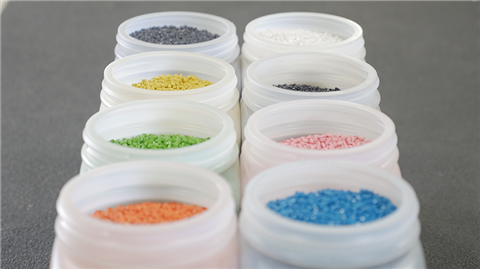 The use of additive manufacturing for end-use parts development is expected to expand as material and machine advancements continue to occur. (Photo: Protolabs)
The use of additive manufacturing for end-use parts development is expected to expand as material and machine advancements continue to occur. (Photo: Protolabs)
“With additively manufactured parts being leveraged by engineers in early development, product teams are able to evaluate quickly and move,” Giebehain said. “Most often we are providing functional prototypes as well as low volume end-use parts.”
End-use parts production is seeing both growth and transformation, he added. “Additive parts work really nicely when lower volumes are required,” he pointed out. Examples can include “end of life parts where it may not make sense to resurrect archived tooling or highly customized parts.”
The use of additive manufacturing for end-use parts development will continue to expand across many industries, Giebehain predicted, as material and machine advancements continue to occur. “This is especially true with sintering 3D printing technologies like Multi Jet Fusion and Direct Metal Laser Sintering, where material construction and part durability is key,” he said.
“Protolabs has already started to see a lot more production activity over the last few years, and I expect we will see that trend continue long into the future,” he noted. One of the primary influences is the increased comfort customers have with 3D printing as a true industrial manufacturing process.
“Roughly a decade ago, 3D printing started to become a mainstream process for prototyping applications and now it’s to the point where many engineers have access to a printer in their office or lab and use it on a very frequent basis,” Giebehain said. “This experience inevitably led to more comfort with the process, which led to using it for more applications, which ultimately led to printing end-use production parts that take full advantage of the process’ capabilities.”
But there are challenges to overcome before larger-scale production becomes more feasible. “Cideas Inc. is constantly adding new materials and technologies as they become available,” said Littrell. Yet, he acknowledges, “The adaptation and utilizing additive manufacturing and 3D printing for typical production scenarios is still hindered by machine speeds, material costs, waste stream and post processing.”
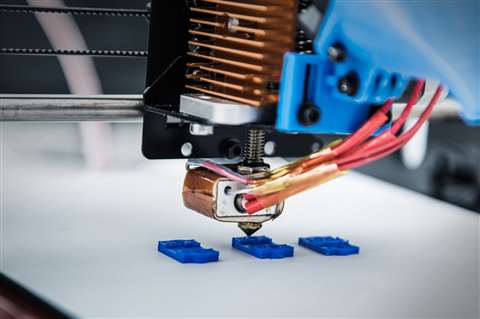 While the additive manufacturing industry is continuing to develop at a rapid pace, cost and the size of parts that can be printed will hinder broader use. (Photo: Caterpillar Inc.)
While the additive manufacturing industry is continuing to develop at a rapid pace, cost and the size of parts that can be printed will hinder broader use. (Photo: Caterpillar Inc.)
Caterpillar recognizes that the additive manufacturing industry is continuing to develop at a very rapid pace, but cost and the size of parts that can be printed continue to hinder its broader use. “Most technologies are currently limited in size and are typically more expensive than traditional manufacturing at high volumes,” Johnson said. “As the industry resolves these two issues, the value and subsequent implementation of additive manufacturing will grow at a significantly increased rate.”
Wacker Neuson sees production costs and material properties as limiting factors, as well. “Most of our product development is involving metal fab. Laser sintering is available but typically the cost compared to traditional fabrication is not viable,” said Lutz.
“The other main limitation is lack of knowledge of the capabilities,” he continued. “I am currently working on creating presentations to give to our manufacturing department in order to show how and what our capabilities are so that they are able to know what is feasible for printing. They are then able to use the printers as another tool for line support/prototyping.”
While such obstacles may slow the move to larger-scale production, Giebehain is optimistic. “As technology advances, costs will ultimately come down, making additive manufacturing economically viable for applications that require larger parts or higher quantities of parts,” he stated.
“Additive manufacturing will never be a do-it-all process for all applications,” he acknowledged. “For high quantities of standard parts, it will be incredibly difficult to match the economics of injection molding or die casting. But I do think 3D printing will become a mainstay in the manufacturing of end-use production parts.”
STAY CONNECTED




Receive the information you need when you need it through our world-leading magazines, newsletters and daily briefings.
POWER SOURCING GUIDE
The trusted reference and buyer’s guide for 83 years
The original “desktop search engine,” guiding nearly 10,000 users in more than 90 countries it is the primary reference for specifications and details on all the components that go into engine systems.
Visit Now
CONNECT WITH THE TEAM










